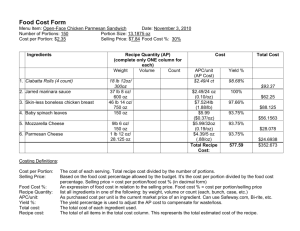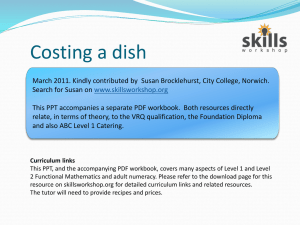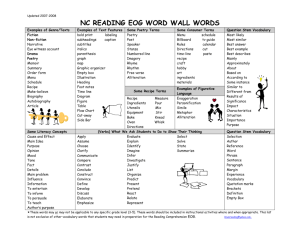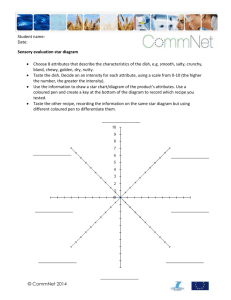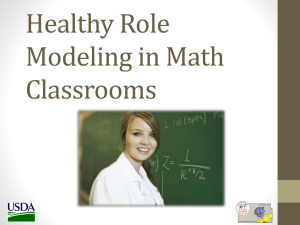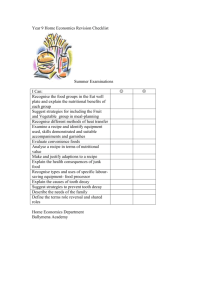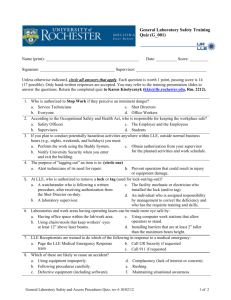100 West 49th Avenue
advertisement
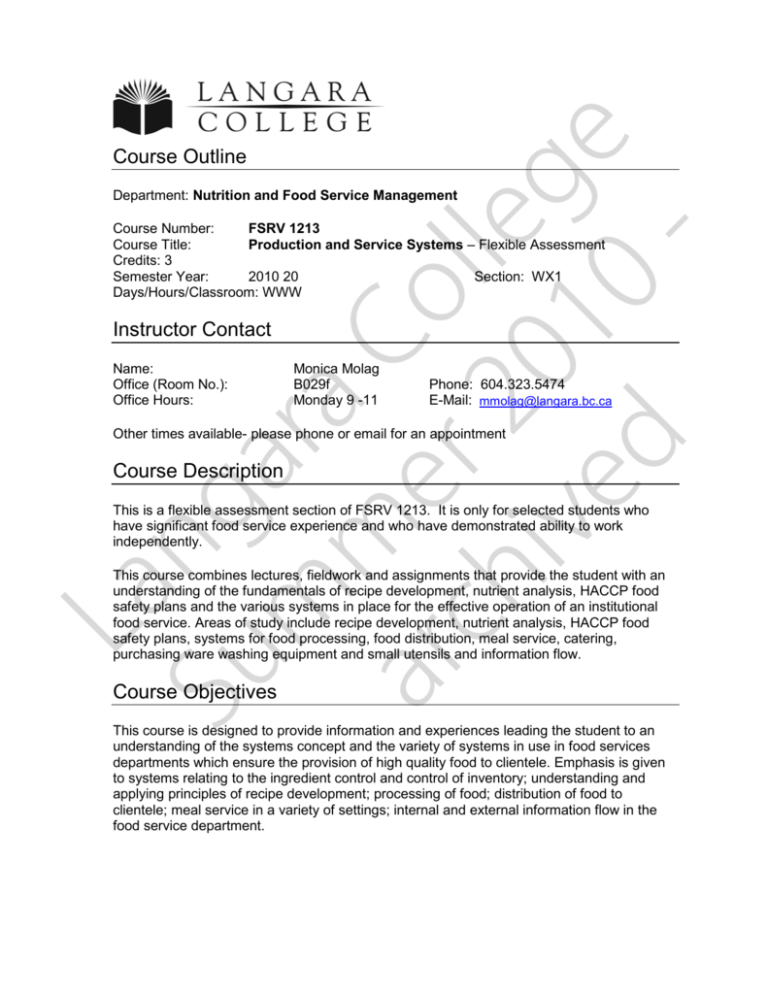
La n Su g a m ra m C ar e o ch r 2 lle iv 01 ge ed 0 Course Outline Department: Nutrition and Food Service Management Course Number: FSRV 1213 Course Title: Production and Service Systems – Flexible Assessment Credits: 3 Semester Year: 2010 20 Section: WX1 Days/Hours/Classroom: WWW Instructor Contact Name: Office (Room No.): Office Hours: Monica Molag B029f Monday 9 -11 Phone: 604.323.5474 E-Mail: mmolag@langara.bc.ca Other times available- please phone or email for an appointment Course Description This is a flexible assessment section of FSRV 1213. It is only for selected students who have significant food service experience and who have demonstrated ability to work independently. This course combines lectures, fieldwork and assignments that provide the student with an understanding of the fundamentals of recipe development, nutrient analysis, HACCP food safety plans and the various systems in place for the effective operation of an institutional food service. Areas of study include recipe development, nutrient analysis, HACCP food safety plans, systems for food processing, food distribution, meal service, catering, purchasing ware washing equipment and small utensils and information flow. Course Objectives This course is designed to provide information and experiences leading the student to an understanding of the systems concept and the variety of systems in use in food services departments which ensure the provision of high quality food to clientele. Emphasis is given to systems relating to the ingredient control and control of inventory; understanding and applying principles of recipe development; processing of food; distribution of food to clientele; meal service in a variety of settings; internal and external information flow in the food service department. La n Su g a m ra m C ar e o ch r 2 lle iv 01 ge ed 0 Learning Outcomes GENERAL LEARNING OUTCOMES: 1. Learn and apply principles of recipe development, standardization and costing. DEMONSTRATES LEARNING OUTCOMES: 1.1. Describes the procedures involved in developing standardized recipes. 1.2. Converts recipes from Imperial measurements to metric measurements and vice versa. 1.3. Expands and decreases recipe yields. 1.4. Completes exercises for recipe costing. 1.5. Costs a recipe developed for a day care centre. GENERAL LEARNING OUTCOMES: 2. Completes nutritional analyzis on recipes. DEMONSTRATES LEARNING OUTCOMES: 2.1. Analyzes recipes for nutritional content. GENERAL LEARNING OUTCOMES: 3. Understand and evaluate food processing systems. DEMONSTRATES LEARNING OUTCOMES: 3.1. Defines and differentiates among conventional, ready foods (cook chill, cook freeze), commissary and assemble serve food processing systems. 3.2. Evaluates food processing systems considering system flow, menu, equipment, space, food safety, nutrition service implications, labour and skills and supervision. 3.3. Compares processing systems to determine feasibility for use in specific sized operations. La n Su g a m ra m C ar e o ch r 2 lle iv 01 ge ed 0 GENERAL LEARNING OUTCOMES: 4. Understand and evaluate ingredient control inventory systems DEMONSTRATES LEARNING OUTCOMES: 4.1. Identifies the role of ingredient control in the maintenance of quality, nutrition and costs in food service operations. GENERAL LEARNING OUTCOMES: 5. Understand and evaluate systems for distribution of food to clientele. DEMONSTRATES LEARNING OUTCOMES: 5.1. Describes and differentiates among food distribution systems and their compatibility to various food processing systems. 5.2. Evaluates food delivery systems with respect to equipment, menu, cost, quality control, sanitation and supervision. 5.3. Compares distribution systems to determine feasibility for use in specific sized operations. GENERAL LEARNING OUTCOMES: 6. Understand and evaluate systems for the service of food to clientele in a variety of settings. DEMONSTRATES LEARNING OUTCOMES: 6.1. Describes procedures used for the service of food to clients. 6.2. Knows proper table setting procedures for different styles of service. 6.3. Describes procedures for planning a special event and dealing with a catering client. 6.4. Identifies different methods of tray service and suitability to facility and clientele. 6.5. Describes different feeding aids used for the physically challenged. La n Su g a m ra m C ar e o ch r 2 lle iv 01 ge ed 0 GENERAL LEARNING OUTCOMES: 7. Understand and evaluate purchasing systems for equipment and small utensils DEMONSTRATES LEARNING OUTCOMES: 7.1. Describes procedures for writing specifications for the purchase of equipment and small wares. 7.2. Identifies grades, standards and government regulations that affect the manufacture, sale and distribution of equipment and small wares. EVALUATION AND GRADING All assignments and the examination must be completed. All student work will be assessed according to the College Code of Academic Conduct (Appendix A Student Handbook). Academic transgressions will have consequences which can be an 'F' grade in the course. Mark Distribution Menu Planning Case Study Field trip Report 15% 10% Recipe Development Case Study 15% Final Exam 60% Total 100% Final percentage grades will be converted to letter grades using the grading scale below Mark 95-100% 90-94% 85-89% 80-84% 75-79% 70-74% Grade A+ A AB+ B G.P.A. 4.33 4.00 3.67 3.33 3.00 B- Mark 65-69% 60-64% 55-59% 50-54% Below 50% Grade C+ C CD F 2.67 G.P.A. 2.33 2.00 1.67 1.00 Nil La n Su g a m ra m C ar e o ch r 2 lle iv 01 ge ed 0 TEXTBOOKS Recommended: • • Gregoire, M.B., Foodservice Organizations: A Managerial and Systems Approach. 7th Edition, Prentice Hall this is the same text as was used in FRSV 1113 Molt, M. Food for Fifty. 13th Ed., Prentice Hall
